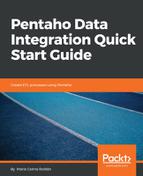As mentioned previously, when you are designing a job, there is a broad list of available job entries, organized in folders. Let's review the list, grouped by general purpose, as follows:
- Working with files: In a job, you can manage files in several ways; you can create folders, move files, delete files, zip or unzip files, transfer files to and from remote servers, and more. You will find the corresponding entries in the following entry folders: File management, File encryption, and File transfer.
- Interacting with databases: You have already learned how to work with databases in a transformation, where you deal with data. With jobs, you have the option to perform more general tasks; for example, you can verify database connections, verify whether a table contains certain data, and run DDL scripts. You will find entries for doing such tasks inside of the following folders: Conditions, Scripting (SQL entry), Bulk loading, and Big Data (Sqoop Export and Sqoop Import).
- Verifying conditions to change the flow of execution: Aside from checking the result of an entry (success or failure), you can create a flow of tasks, based on the result of evaluating a condition. Examples of these conditions include checking whether a file exists, evaluating file metrics, and comparing the value of a variable with an expected value. Once the condition is evaluated, you can take one way or another in the flow depending on the result of the evaluation. There are entries devoted to this, and, as you may have guessed, all of them are inside of the Conditions folder.
- Dealing with big data: There is a dedicated folder for working with big data tools and frameworks. In particular, one of the first big data technologies integrated with PDI was Hadoop. In a PDI job, you can run Hadoop jobs, copy files from and to the Hadoop filesystem, and run the Sqoop tool for importing and exporting data from and to HDFS.
The preceding list is not intended to be a full list of entries and categories, but rather an overview of the main (or most useful) ones.
As you already know, using an entry is just a matter of linking it as a part of your flow and configuring the behavior in its configuration window. As an example, the next subsection describes how to use the Mail entry to send an email, which is a very common requirement.
